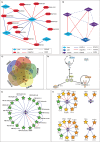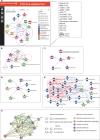A roadmap to the molecular human linking multiomics with population traits and diabetes subtypes
- PMID: 39160153
- PMCID: PMC11333501
- DOI: 10.1038/s41467-024-51134-x
A roadmap to the molecular human linking multiomics with population traits and diabetes subtypes
Abstract
In-depth multiomic phenotyping provides molecular insights into complex physiological processes and their pathologies. Here, we report on integrating 18 diverse deep molecular phenotyping (omics-) technologies applied to urine, blood, and saliva samples from 391 participants of the multiethnic diabetes Qatar Metabolomics Study of Diabetes (QMDiab). Using 6,304 quantitative molecular traits with 1,221,345 genetic variants, methylation at 470,837 DNA CpG sites, and gene expression of 57,000 transcripts, we determine (1) within-platform partial correlations, (2) between-platform mutual best correlations, and (3) genome-, epigenome-, transcriptome-, and phenome-wide associations. Combined into a molecular network of > 34,000 statistically significant trait-trait links in biofluids, our study portrays "The Molecular Human". We describe the variances explained by each omics in the phenotypes (age, sex, BMI, and diabetes state), platform complementarity, and the inherent correlation structures of multiomics data. Further, we construct multi-molecular network of diabetes subtypes. Finally, we generated an open-access web interface to "The Molecular Human" ( http://comics.metabolomix.com ), providing interactive data exploration and hypotheses generation possibilities.
© 2024. The Author(s).
Conflict of interest statement
The authors declare the following conflicts of interest: M.P.B. and G.L. are working for or have stakes in Genos Ltd., a private company specialized in glycomics analyses. All the other authors declare no competing interests.
Figures





References
MeSH terms
LinkOut - more resources
Full Text Sources

